AURORA/BETHEL TIMELINE
1812: Wilhelm (William) Keil, who would later found the movement, was born in Prussia.
1836: Keil and his wife Louisa came to the United States, living first in New York and then Pittsburgh.
1844: With about 200 followers, Keil founded the Bethel colony in Missouri.
1853: A team of scouts was sent from Bethel westward to seek a new location for the community. They reported that Willapa Bay, in what is now the state of Washington, would be a good choice.
1855: A significant fraction of the Bethel colony, led by Keil, took the long trek to Willapa Bay and prepared to set up new homes.
1856: Keil decided that Willapa Bay was not suitable, purchased land in what was to become the state of Oregon, and named the community Aurora.
1862: Smallpox killed four of Keil’s children at Aurora, including the thirteen-year-old girl after whom the colony had been named.
1877: William Keil died, leaving Aurora without a leader.
1883: Dissolution of the Aurora and Bethel colonies was finalized, as the last property became privately owned.
FOUNDER/GROUP HISTORY
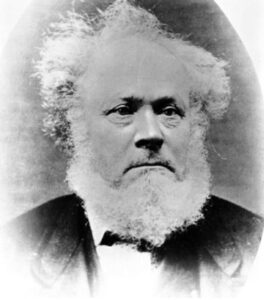
Like many of the other religious communities founded in the United States in the nineteenth century, Bethel and its successor Aurora, were created by German immigrants who adapted their traditional religion as a basis for its social and economic structure. The leader, Wilhelm (William) Keil, [Image at right] was born in Prussia in 1812 and came to the United States in 1836 with his wife Louisa. After a brief time in New York, they moved to Pittsburgh. Keil was a self-taught “doctor” of herbalism before modern medicine, and he interacted in complex ways with existing religious movements before founding his own.
Once the Bethel community was founded in Missouri in 1844, its history became rather stable and well-documented, but the decade before that remains open to debate. One reason is that a primary historical source was written by an opponent, Carl G. Koch, who had competed with Keil within the German Evangelical community while Keil was still in the process of developing his distinctive religious movement. Translating the German text, we see many words and phrases that described Keil very harshly, including “driven by Satan,” “self-idolatry,” “charlatan,” and “swindler” (Koch 1871:135-36). However, Keil’s many followers did not see him this way, and they even included Koch’s brother Friedrich. (named Frederick Cook in the 1850 census of Bethel, and Frederick Koch in the 1860 census; born in Prussia 1815).
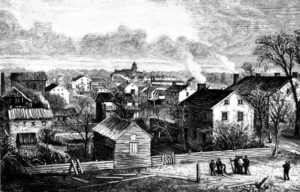
When Aurora and Bethel [Image at right] were both well-established, two books influentially defined the scope of American religious communes, History of American Socialisms by John Humphrey Noyes (1870), leader of the Oneida commune, and The Communistic Societies of the United States by Charles Nordhoff (1875), a travelogue writer. Noyes was aware of the existence of Bethel, but wrote nothing about it, merely noting that there were eleven pages about Bethel in the trove of documents he inherited from A. J. Macdonald who had died of cholera before he could write his book about socialist communities. Nordhoff (1875:306-307) visited Aurora, devoted a chapter to it, and reported this about Keil’s early years in America:
He became a mystic, and he seems to have dealt also in magnetism, and used this as a curative agent for diseases. After living for some time in New York, he came to Pittsburgh, where he gave himself out as a physician, and showed, it is said, some knowledge of botany. He professed also to be the owner of a mysterious volume, written with human blood, and containing receipts for medicines which enabled him, as he professed, to cure various diseases. Presently he became a Methodist, and thereupon burned this book with certain awe-inspiring formalities. He seems to have been a fanatic in religious matters, for he soon left the Methodists to form a sect of his own; and it is related that he gathered a number of Germans about him, to whom he gave himself out as a being to be worshiped, and later as one of the two witnesses in the Book of Revelation; and in this capacity he gave public notice that on a certain day, after a fast of forty days, he would be slain in the presence of his followers.
Presumably, the meaning of “magnetism” in this paragraph is some variant of the hypnotism developed by German doctor Franz Mesmer who believed in the existence of a mystical force possessed by all living beings, often called “animal magnetism” (Darnton 1970). Nordhoff then very briefly reports that Keil exploited a schism in the nearby millenarian intentional community called Harmony. Its leader, George Rapp, made the mistake of identifying one of his followers as the possible Lion of Judah, who using the name Count de Leon led a break-away group and then promptly died, leaving a few dozen of his followers in limbo. A few of them later joined Keil when he founded Bethel (Stanton 1963).
Nordhoff reports that Keil’s followers set up mills for wood, wool, and grain, establishing Bethel as a functional town that could serve the needs of farmers in the area. Indeed, in the records of the U.S. census it is very difficult to identify the border between the intentional community and the surrounding population. When one examines the public census records for Oneida and the Shakers during the 1840-1880s, those communes are very clearly marked, but that is not the case for Bethel and Aurora.
DOCTRINES/BELIEFS
The strong religious focus of Bethel and Aurora has been identified as a main reason they survived relatively long in the diversity of communal experiments that were active in the nineteenth century in the United States (Kanter 1972; Latimore 1991). Founded as they were by German immigrants, Bethel and Aurora can be placed within the general German Pietist tradition, which had some communal qualities but was rather diverse and thus difficult to define precisely (Lehmann 1982; Strom 2002). David Nelson Duke (1993:89) has provided a plausible but highly dynamic classification within Pietism, suggesting that Keil was a charismatic leader who strategically changed the belief system whenever that seemed advantageous. The result was three stages in the development of the religion, two of which contained a pair of substages: Stage 1. Revivalism (1838-1842): A. Methodist, B. Independent; Stage 2. Apocalypticism (1842/3-1844); Stage 3. Communalism (1844-1879): A. Bethel, Missouri, B. Aurora, Oregon.
In the Apocalypticism stage, Keil apparently was exploiting the interest in Millerism that anticipated the Second Coming in 1844 and led to the emergence of Adventism (Bainbridge 1997:89-118). Duke states that the expedition westward from Bethel to Aurora was Keil’s response to dissension at Bethel. Thus it had some of the qualities of a schism, or perhaps a “reverse schism” in which the leader departs with many loyal members, rather than a departure of some dissatisfied members.
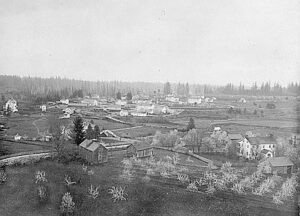
By the time Bethel had been established, the group’s Pietism stressed emotional constraint, yet Keil’s personal feelings for his own children are suggested by the fact that the Aurora colony [Image at right] was named after his youngest daughter Aurora, who was born in Bethel. During his visit to Aurora, Nordhoff (1875:319) interviewed Keil as they walked around the colony, until they came to a spot
where I saw an uncommon sight, five graves close together, as sometimes children’s are made; but these were evidently the graves of grown persons. “Here,” he said, “lie my children all I had, five; they all died after they were men and women, between the ages of eighteen and twenty-one. One after the other I laid them here. It was hard to bear; but now I can thank God for that too. He gave them, and I thanked him; he took them, and now I can thank him too.” Then, after a minute’s silence, he turned upon me with sombre eyes and said: “To bear all that comes upon us in silence, in quiet, without noise, or outcry, or excitement, or useless repining that is to be a man, and that we can do only with God’s help.”
The gravestones of the children remain visible as they were photographed on the website Find A Grave for Keil Family Cemetery at Aurora. However, we quickly see errors in Nordhoff’s report, because the ages of the children were thirteen to twenty, the youngest being Aurora after whom the colony had been named, and two other children were added only long after Nordhoff’s visit, in 1883 and 1902. The graves Nordhoff saw were actually of four children who had died from smallpox from November 22, 1862 until Aurora’s passing on December 14. The fifth already-deceased child, Keil’s son William, had been buried at Willapa but had died months earlier and far eastward in Bethel, reportedly from malaria. Obsessed with taking to the promised land the son who had inherited his name, Keil had the body placed in a box filled with whisky for preservation, which led the wagon train from Bethel to Willapa.
RITUALS/PRACTICES
Like other religious communes of its period, Bethel and Aurora required the wearing of plain and rather uniform clothing, stressing modesty and minimizing individual styles (Lauer and Lauer 1983). William Hinds (1908:327) had visited Bethel in 1876, and he found it to be “the most prosaic and matter-of-fact of all the larger Communities.” With some effort, Hinds (1908:332) was able to expand this description only slightly:
The Bethelites had few distinctive principles, but they were certainly of the sterling sort. They made little account of formalities and ceremonies, and much account of a practical Christian life. They meant to live, they said, as moral men ought to live, the elder members taking the lead of the younger in good example, as the founder of the Society had taken the lead of all. All strove to manifest their love one toward another; all willingly forgave injuries; all were esteemed according to their real character and not according to appearances; riches and poverty were abolished; the scriptural injunction which requires first of all obedience to God was respected by all. A man can be saved, they held, only by becoming a “new creature” in Christ Jesus; and then if he has lied he will lie no more; if he has stolen he will steal no more, and if possible will make double restitution; and in all things he will seek to do good rather than evil. A man’s whole duty, in short, is to do right and live unselfishly. To my questions about their constitution and by-laws they replied, “The word of God is our constitution and by-laws.”
ORGANIZATION/LEADERSHIP
There are two entangled ways to conceptualize the organizational structure of Aurora and Bethel, either as a family of families, or as people connected through property owned or at least administered by Keil. Philip Dole (1991:382) observed that at least in the abstract Bethel and Aurora followed values apparently derived from Harmony: “(1) all property would be held in common; and (2) everyone would work for the welfare of the community, providing for one another.” But the effective way of holding property “in common” seems to have been for Keil to own it. The original manuscript pages of the U.S. census in 1870 list 307 residents of Aurora with a total “personal estate value” of $68,100, of which $60,000 belonged to Keil. The total real estate value was $94,780, of which he reportedly owned $40,000. Of course, these numbers are uncertain, as is the dollar inflation since then, especially for real estate, and we cannot rely upon the estimate of many online inflation calculators that one dollar in 1870 equals twenty dollars in 2020. Also, the exact boundary between members and neighbors in the census is unclear. But these numbers illustrate that even late in his life, Keil controlled much of the colony’s wealth.
The primary social structure of Bethel and Aurora was relatively conventional for that period of history, extended families. The website for the current Aurora Colony museum says that a total of fifty-four families had been involved in the Oregon half of the community, and it has special pages for seventeen family names that connect to some of their descendants. The 1870 census of Aurora lists 138 females and 169 males, and the gender imbalance may simply result from the fact that Aurora was in the “Wild West” and its initial colonization effort had involved more males. Of these 307 members, 115 were under the age of twenty, and the average age was only twenty-eight. Based partly on his interview with Keil, Charles Nordhoff (1875:309-310) summarizes the family-centric conception of the community:
1st. All government should be parental, to imitate, as they say, the parental government of God. 2d. That therefore societies should be formed upon the model of the family, having all interests and all property absolutely in common ; all the members laboring faithfully for the general welfare and support, and drawing the means of living from the general treasury… 6th. The system of government is as simple as possible. Dr. Keil, the founder, is president of the community, and autocrat. He has for his advisers four of the older members, who are selected by himself. In the management of affairs he consults these, whose opinions, I imagine, usually agree with his. When any vitally important change or experiment is contemplated, the matter is discussed by the whole community, and nothing is done then without a general assent.
In an article about Keil’s influence on marriage between members, the difficult transition as he allowed some members to take property for their families in his latter years, and the structure of resultant families as documented in the 1900 census. Kimberly Swanson (1991:418) described his power at the beginning of Bethel:
At the outset of the undertaking he aborted an attempt by some followers to establish a written agreement specifying requirements for membership in the community. That failed “constitutional” effort indicated a desire on the part of some members to limit Keil’s power. When Keil responded by asserting that the Bible would serve as the colony’s foundation and that the Golden Rule would guide the colonists’ actions, his challengers acquiesced. Whether Keil encouraged or discouraged personal interpretations of the Bible is unknown. He did allow at least two members to act as missionaries and recruit members during the establishment of the Bethel colony, and naturally he transferred some authority to the trustees in Bethel when he moved to Aurora.
However, it remains unclear if Keil had much influence over Bethel after he went westward to Aurora. The 1860 census indicates that Bethel property valued at $75,000 was held by Samuel Miller, and when Hinds (1908:334) visited in 1876, “Mr. Miller” was Deputy-President and would preach at the religious services held in the community’s church every other week.
Several of the best-known mid-nineteenth century religious communes were economically successful, and their dissolution may often have resulted from the fact that a charismatic, or at least well-established, leader could not find a successor. Father Keil’s son William had been born in 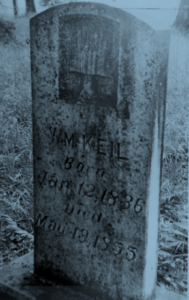 1836, and so had he survived the malaria he would have been mature in 1877 when his father died. [Image at right] Given the community’s social separation from the secular world, he could have been trained to assume his father’s sacred role.
1836, and so had he survived the malaria he would have been mature in 1877 when his father died. [Image at right] Given the community’s social separation from the secular world, he could have been trained to assume his father’s sacred role.
ISSUES/CHALLENGES
The most obvious challenge for Keil’s movement was its constant search for the perfect location, or for spiritual perfection that would manifest itself somewhere. Founded in Pennsylvania, it established its first colony in Missouri, then sought better homes in the states of Washington and Oregon without officially relinquishing the Missouri colony.
A central issue for Keil’s group when it existed, and for scholars today, is that neither detailed official histories nor extensive evangelical statements are available to balance with the observations of visitors such as Charles Nordhoff or William Hinds. Unlike some of the more prominent religious communes of its era, it did not promote its vision through extensive publications.
As Stanton argued in her 1963 thesis, many publications about the group seem inaccurate, perhaps distorted by incorrect reports by opponents of the group or journalists who overdramatized the facts, back when the group was in existence. In his 1933 supposedly factual book Bethel and Aurora, Robert J. Hendricks explicitly added dialog he invented himself, apparently to make history seem alive. More recently, two novelists have used Bethel and Aurora as their settings, potentially distorting history further. However, writing in The Oregon Historical Quarterly, James Kopp (2009) has argued that these fiction authors were sufficiently dedicated to know the history well and made plausible inferences about the reality that was not explicitly documented in any library.
The first example is Second Eden, by Cobie de Lespinasse, published in 1951. She was a local resident in Oregon who knew some of the descendants of the colonists, including Clark Moor Will who gave her access to his extensive document collection. The story focuses on Keil’s possible erotic relationships with young women over the course of years, not making him out to be an extreme exploiter such as John Humphrey Noyes at Oneida seems to have been, but gentle in his domination. Before the novel begins, this text provides the conceptual framework: “There is a teaching that the most perfect government is a kingdom, presupposing an absolutely wise, unselfish, just and good king; and one who could transmit these attributes indefinitely. No such king ever lived or ever will live, and no king, approaching these qualities, can transmit them.” Checking online, we can see that the author found this quote in the local Sunday newspaper, The Statesman from Salem, Oregon, March 28, 1926. The “king” in the novel of course, was Keil. But the novel is carefully written, thoughtful, and expresses some admiration for the people of Aurora. The website of the museum reports that as a token of respect and friendship, in 1951 Aurora descendant Anna Stauffer gave de Lespinasse a poem that begins:
High every head with courage,
Faith was their banner strong,
As their wagons rolled on westward,
They poured out their hearts in song.
When Charles Nordhoff visited both Bethel and Aurora in the early 1870s,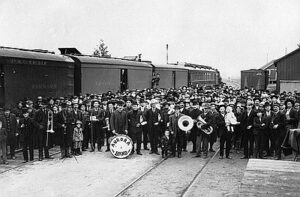 he listened to community bands play at both locations, so music was a central feature of the culture. [Image at right] Deborah Olsen (1991:360) has suggested that a musical relic of Bethel, the Schellenbaum or bell tree, while not exactly sacred, was “a symbol of allegiance to the colony leader and to the communal ideal.” In her novel about the community, de Lespinasse dramatized how this device should symbolize that Bethel was a harmony of like-minded people, each represented by one of the bells (de Lespinasse 1951:74):
he listened to community bands play at both locations, so music was a central feature of the culture. [Image at right] Deborah Olsen (1991:360) has suggested that a musical relic of Bethel, the Schellenbaum or bell tree, while not exactly sacred, was “a symbol of allegiance to the colony leader and to the communal ideal.” In her novel about the community, de Lespinasse dramatized how this device should symbolize that Bethel was a harmony of like-minded people, each represented by one of the bells (de Lespinasse 1951:74):
In reality the schellenbaum was a small mountain of bells of all sizes and it measured a full two feet across and stood over six feet high. There had to be a certain deftness and surety in carrying this tinkling structure at the head of a procession or marching group so that all the bells, large and small, might ring in rhythmic marching cadence at the proper time. The schellenbaum glistened in the sun, it scintillated with every movement, it was musical, rhythmic – no wonder the children tried to march as closely to it as possible to see the shimmering of the tinkling mass of bells!
The second example of historically valid fiction is the trilogy of novels Change and Cherish by Jane Kirkpatrick, originally published in 2006, 2007 and 2008, then combined in 2013 as Emma of Aurora. Published along with extensive documentation of where the author got her information, this is the story of Emma Wagner Giesy, a woman who grew up within the commune but retained a sense of independence. All the named characters appear to have been real people, although the details of their lives are largely lost, so much of the trilogy’s realism comes from its description of physical 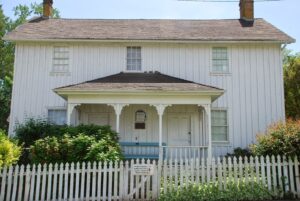 locations and of the practical details of daily life on the frontier. Mostly told from the first person, the story contains many incidents when men dominate women, but more with insults or lack of sympathy rather than erotic misbehavior. The house Emma lived in at Aurora [Image at right] is well described in the original 1973 document that got Aurora Colony into the National Register of Historic Places:
locations and of the practical details of daily life on the frontier. Mostly told from the first person, the story contains many incidents when men dominate women, but more with insults or lack of sympathy rather than erotic misbehavior. The house Emma lived in at Aurora [Image at right] is well described in the original 1973 document that got Aurora Colony into the National Register of Historic Places:
The early history of the house is not clear. The local tradition is that the house was built for Emma Giesy in the early or mid 1860’s. Although the house has characteristics of early Colony period architecture, it may be of a later date, as Emma Giesy did not come to Aurora until 1874. Emma Wagner Giesy (1833-1916), a daughter of David Wagner, was born in Pennsylvania. She accompanied her husband, Christian Giesy, when he led the party of eight men sent west from Bethel, Missouri in 1853 to find a new location for the Colony. They settled in Willapa, Washington Territory, and there Christian Giesy died in 1857.
In the extensive supportive materials included in the one-volume publication of her trilogy, Kirkpatrick (2013:1137) provides evidence that indeed Emma moved from Willapa to Aurora in 1861 to get away from her abusive second husband, and she apparently moved away some years later, perhaps to live with her parents nearby, before returning around 1874. An interesting point related to her house is that in the novel she does not like the location where Keil had it built for her, and today the house has been moved to a new location. At multiple points in the third novel, Emma comments how symbolically meaningful it is that the house has two front doors, and indeed it does. Given the relative dearth of distinctive scriptures or diaries from Bethel and Aurora, and the intentional austerity of the lifestyle, small practical details can be significant: two front doors on a home could mean that there is more than one way to enter Heaven.
IMAGES
Image #1: George Keil.
Image #2: Bethel Community.
Image #3:Aurora Community.
Image #4: George Keil’s grave marker.
Image #5: Aurora Community band.
Image #6: Emma Wagner Giesy House.
REFERENCES
Bainbridge, William Sims. 1997. The Sociology of Religious Movements. New York: Routledge.
Darnton, Robert. 1970. Mesmerism and the End of the Enlightenment in France. New York: Schocken.
de Lespinasse, Cobie. 1951. Second Eden. Boston: Christopher.
Dole, Philip. 1991. “Aurora Colony Architecture: Building in a Nineteenth-Century Cooperative Society.” Oregon Historical Quarterly 92:377-416.
Duke, David Nelson. 1993. “The Evolution of Religion in Wilhelm Keil’s Community: A New Reading of Old Testimony.” Communal Societies 13:84-98.
Hendricks, Robert J. 1933. Bethel and Aurora. New York: Press of the Pioneers.
Hinds, William Alfred. 1908. Co-Operative Colonies. Chicago: Charles H. Kerr.
Kanter, Rosabeth Moss. 1972. Commitment and Community. Cambridge, Massachusetts: Harvard University Press
Kirkpatrick, Jane. 2013. Emma of Aurora. Colorado Springs, CO: WaterBrook.
Koch, Carl G. 1871. Lebenserfahrungen. Cleveland: Verlagshaus der Evangelischen Gemeinschaft.
Kopp, James J. 2009. “Novel Views of the Aurora Colony.” The Oregon Historical Quarterly 110:166-93.
Latimore, James. 1991. “Natural Limits on the Size and Duration of Utopian Communities,” Communal Societies 11:34-61.
Lauer, Jeanette C., and Robert H. Lauer. 1983. “Sex Roles in Nineteenth-century American Communal Societies.” Communal Societies 3:16-28.
Noyes, John Humphrey. 1870. History of American Socialisms. Philadelphia: Lippincott.
Nordhoff, Charles. 1875. The Communistic Societies of the United States. New York: Harper.
Lehmann, Hartmut. 1982. “Pietism and Nationalism: The Relationship between Protestant Revivalism and National Renewal in Nineteenth-Century Germany.” Church History 51:39-53.
Olsen, Deborah M. 1991. “The Schellenbaum: A Communal Society’s Symbol of Allegiance.” Oregon Historical Quarterly 92:360-76.
Stanton, Coralie Cassell. 1963. The Aurora Colony, Oregon, Oregon State University. Accessed from ir.library.oregonstate.edu/concern/graduate_thesis_or_dissertations/fj236693f on 10 August 2020.
Strom, Jonathan. 2002. “Problems and Promises of Pietism Research.” Church History 71:536-54.
Swanson, Kimberly. 1991. “‘The Young People Became Restless:’ Marriage Patterns before and after Dissolution of the Aurora Colony.” Oregon Historical Quarterly 92:417-31.
SUPPLEMENTARY RESOURCES
Old Aurora ColonyMuseum website. 2020. Accessed from auroracolony.org on 10 August 2020. Few of the documents in the museum library are available online. Researchers must visit the physical museum, or request copies of documents.
Stanton, Coralie Cassell. 1963. The Aurora Colony, Oregon. Masters Thesis, Oregon State University. Accessed from https://ir.library.oregonstate.edu/concern/parent/fj236693f/file_sets/6t053m739 on 10 August 2020.
An appendix lists followers of Count de Leon, and Stanton was able to identify only eleven of their exact names in Aurora records. Stanton summarized what had been written about Bethel and Aurora, but worried that much of the group’s history was unreliable and even fanciful.
Publication Date:
10 October 2020
